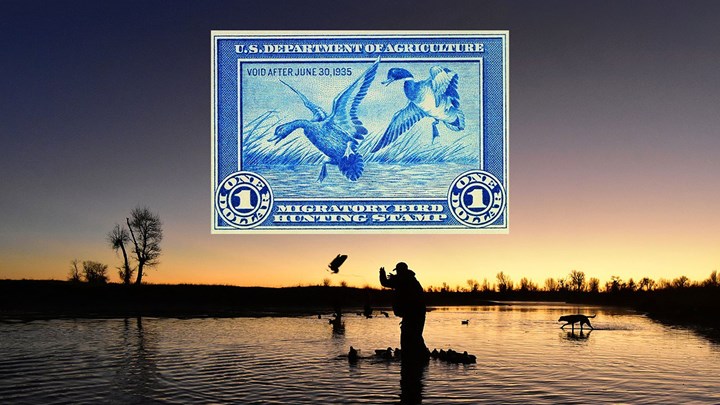
by Cody McLaughlin - Monday, October 2, 2023

America’s first duck stamp, pictured above, went on sale nearly 90 years ago in 1935.
Accessing your duck stamp afield may have just become much easier after the Senate recently passed the bi-partisan Duck Stamp Modernization Act of 2023 in a unanimous vote. The bipartisan move, which follows the passage of the House’s companion bill in July, seeks to permit states to issue fully electronic versions of the stamps and is a priority bill for sportsmen organizations including the NRA, Ducks Unlimited, Delta Waterfowl, the Congressional Sportsmen’s Foundation and many others.
For nearly 90 years waterfowl hunters, through the purchase of federal duck stamps, have supported the conservation of more than 6 million acres of strategic wetland habitat—not to mention the additional financial aid coming from hunters buying sister stamps at the state level. Celebrating this fact, the landmark legislation was built off a successful pilot program validating E-Stamps for 45 days, which allowed ample time for hunters to receive their duck stamps in the mail, but now extends use of the electronic stamp for the entire waterfowl season. Ushering in an exciting new chapter in the Federal Duck Stamp program, the E-stamp option enhances waterfowl hunters’ accessibility to the stamp while ensuring the future of the critical habitat conservation initiatives the stamp funds.
If signed by President Biden, the federal government would be in step with the 27 states, such as my home state of Alaska, that currently embrace this modern and convenient method for hunters to carry their paperwork afield. Considering that waterfowl hunting conditions are generally not conducive to keeping a signed piece of paper in pristine condition for wardens to check, being able to pull up the stamp on a smart phone makes sense. For hunters who wish to purchase the actual stamp, duck stamps would remain available for purchase from the U.S Postal Service and other traditional authorized retailers.
America’s duck stamp was conceived in 1934 when Congress passed and President Franklin D. Roosevelt signed the Migratory Bird Hunting Stamp Act into law. The name was later changed to the Migratory Bird Hunting and Conservation Act but is most commonly referred to as the Duck Stamp Act. The first stamp went on sale in 1935 (pictured above) and was designed by J.N. “Ding” Darling, the director of the Bureau of Biological Survey, today known as the U.S. Fish and Wildlife Service. Ninety-eight percent of duck stamp sales continue to go directly toward the Migratory Bird Conservation Fund. Thanks to authorizing the use of electronic stamps throughout the entire waterfowl hunting season, Congress is ensuring the continuation of a near nine-decades-old legacy while making it that much easier for hunters to continue helping to acquire and protect wetland habitat.
About the Author
Cody McLaughlin is a conservationist and conservative thought leader on public policy issues including hunting, fishing, gun rights, free-market tax and wage policy and the environment. He recently launched Trout Stream Studios as an executive producer for podcasts and livestreams in the hunting and veterans’ affairs spaces, including for the popular Blood Origins Podcast and the Veterans’ Affairs Administration’s National Center for PTSD. He also works as an advertising consultant for conservative political causes, managing clients’ digital communications and online presence. He currently on the board of the Alaska Outdoor Council, the Last Frontier’s State’s NRA affiliate, and is a former board member and lead spokesman of the New Jersey Outdoor Alliance.
E-mail your comments/questions about this site to:
[email protected]
